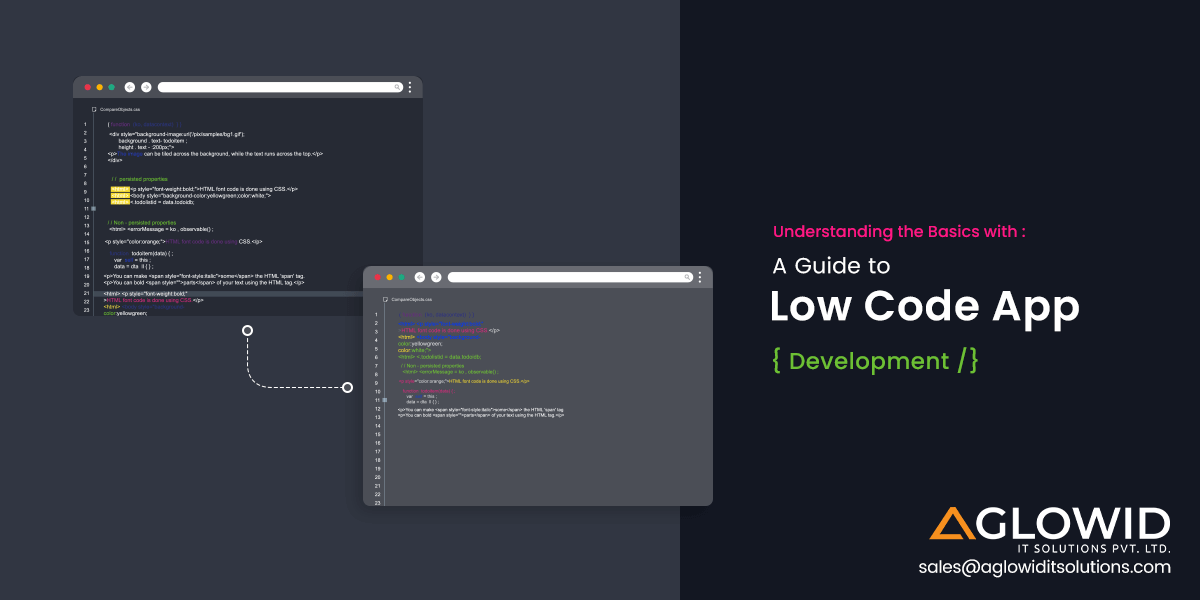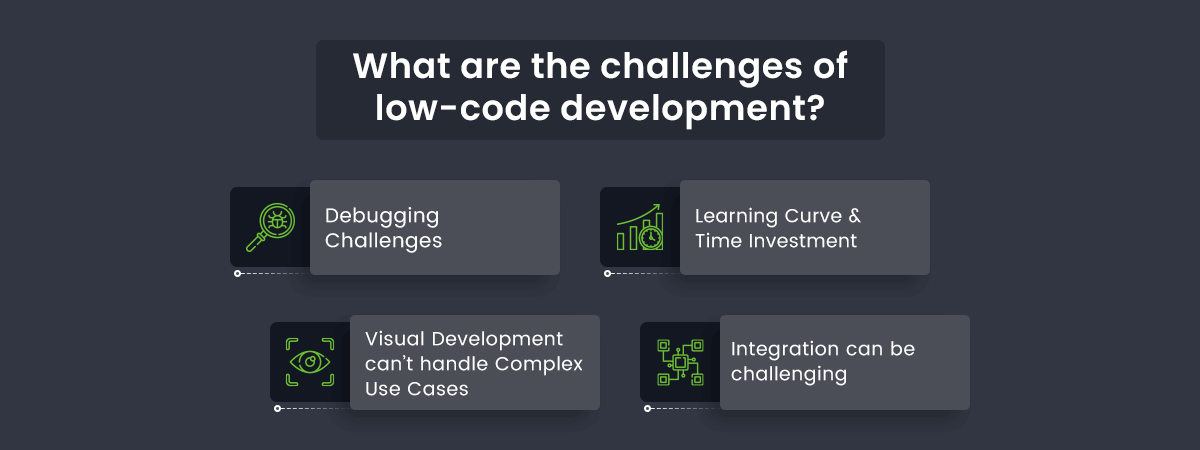Quick Summary: Looking for a quick, economical, and hassle-free app development process for your app requirements? Skeptical about Low Code App Development? Here we will discuss everything you need to know about building an app using low code development best practices.
Over the years, app development has attracted more and more industries, individuals, and businesses as apps have become the heart and soul of our day-to-day activities and are also capable of carrying out essential and complicated tasks like banking, data analysis, and more. Certainly, the value of coders has increased significantly to get these mammoth-like apps functioning in perfect rhythm and efficiency.
However, with the advent of COVID-19 and other financial challenges across the globe, going online with your business has become more of an absolute necessity rather than a decorative add-on. And with the impact this global pandemic has had on the job opportunities around the globe, not many people can afford the traditional mobile app development approach to build their mobile/web apps. Hence, more and more people have started taking notice of ‘Low-Code App Development’ and ‘No-Code App Development’ for getting their app solutions with lesser technical hassle and lowered prices. We need to start from the basics to understand the potential and challenges with low code development truly.
- What is low-code development?
- Importance of low-code app development – market stats 2021
- Low code VS. Traditional coding – which to choose
- Low code app development principles
- Benefits of low code development
- What are the challenges of low-code development?
- Low code app development products
- What apps can you build with low code?
- Selction criteria for choosing the best low code app development platform
- Popular low-code app development platforms in 2024
What is Low-Code Development?
Low-Code app development is a software development approach. As the name suggests, low-code app development requires little to no coding for developing processes and applications. It relies on utilizing visual interfaces with simple logic and drag-and-drop features to use detailed coding languages. This approach helps users with less or no prior experience in software development or coding build their apps for different purposes like mobile and business apps.
This ease of developing an app has given rise to a whole new stratum of developers known as ‘Citizen Developers’ as non-developers can also easily use a low code app development platform to create essential apps. However, this is not to say that the low-code development process is limited to citizen developers; many professional developers are also adapting to this app development approach, increasing demand for it.
Importance of Low Code App Development – Market Stats 2021
Reduced time to market and ‘citizen developers’ are two of the primary reasons for the sudden increase in popularity of these low code development platforms.
As per Statista, the global low-code platform market revenue was valued at 13 million US dollars in 2020, which is expected to rise to 65 billion US dollars by 2027.
Gartner Reports – 75% of large enterprises would be using at least four low-code development tools by the year 2024 for their IT services and citizen development initiatives.
Low Code vs. Traditional Coding – Which to choose
So is low code the future for the app development industry? Will it replace traditional coding practices entirely? Not really. Low-code app development is an essential addition to the overall application development industry, but to suggest that it has the power to outweigh traditional coding entirely is a bit farfetched. Low-code development caters to a different market than traditional coding. It should be used as a supplementary service to traditional clothing when many app backlogs are piled up to complete. Low-code app development also has its uses and importance.
When to use Low-code development?
- For Internal Business Department that needs Agile Transformation
- For Specific Customization Solutions
- Enabling the Business Users to build Quick Applications
1. For Internal Business Departments that need Agile Transformation
Many enterprises have departments that constantly want to implement different ideas to improve the functioning of their department. For instance, Marketing, HR, Operations, and more. In such cases, traditional development won’t keep up with the continuous changes needed in such use cases. Also, these internal transformations need to have a high speed-to-market pace for optimizing their effectiveness. For such use cases, low-code app development can be an ideal alternative by enabling quick changes and easy roll-backs to match the pace of these dynamic changes.
2. For Specific and Customizable Solutions
Certain internal business problems are unique and specific to some particular departments, and they need specific solutions. If you try traditional development, it can be costly and not worth the efforts/investments. Longer development times, delayed feedback loops, and utilizing so many skilled resources for the internal project is not desirable or practical.
Hence, you can quickly build and rebuild apps as per the changing requirements by opting for low-code application development. Then the scale of the app can be expanded as per the department’s requirements at different times. This ensures cost optimization.
3. Enabling the Business Users to build Quick Applications
Business users are the ones with innovative ideas and philosophies that they want to implement in their business. However, they are often held back due to their inexperience or lack of technical skills to implement those ideas. Traditional development requires in-depth coding skills that are reserved with IT professionals.
Low-code development changes and challenges this dependency by enabling business users to design their innovative apps as per their vision and needs. They can easily make simple user interfaces and easy-to-follow designs without wasting the time and effort of the IT department. This results in a faster app development process and reduces the percentage of missed opportunities.
Low Code App Development Principles
Low-code app development utilizes a high degree of automation in its approach. However, the development processes and platforms are not automatic. Hence, to obtain the best results, you need to know and follow the sound principles of low code app development.
- Avoid customizations
- Reuse customizations
- Keep the project on-track
- Be available for the low-code team
- Participate in the low-code development platform selection
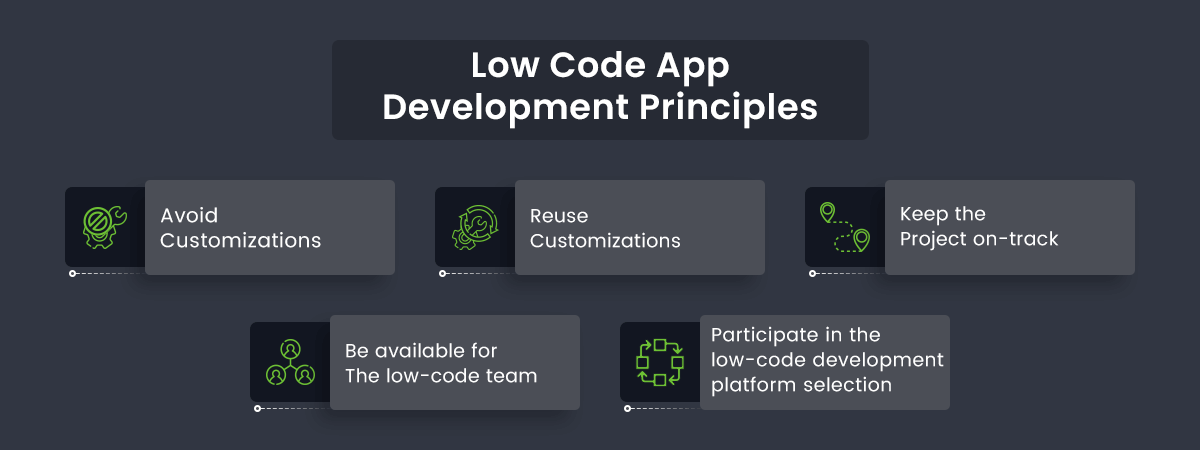
1. Avoid customizations
The efficiency in low-code app development comes from its predefined components that can be easily dragged and dropped in your workflow. These components are usually very generic and can fit different use cases. Now you can modify these existing components or add new ones like UI and visual design elements, but making such customizations will only increase app development time and efforts behind them. It will inevitably increase the cost and speed of the app launch too, which goes against the very purpose of low-code app development practices.
2. Reuse customizations
Avoiding customization whenever possible is the best solution, but it is not always practically possible. Your application will need particular customization to cater to your specific needs. One workaround to minimize dependency on more customizations is to think from the context of everyday use goals. Design and plan your customizations so that they can be reused in other projects or other parts of the same project.
3. Keep the project on-track
Low-code development makes it easier for developers to mix and match new or different features to get the same task done faster and easier. While this is true, you should put in efforts to lay out a project plan and a roadmap so that various stakeholders involved in the project can be involved for any changes to features and requirements.
4. Be available for the low-code team
Just because low-code software development projects are easier than traditional software development projects doesn’t mean that the team working on the low-code project with the right low-code app development tools won’t have any doubts or hesitations about the project details. As product owners and key stakeholders, you should always be available to address any queries and take suggestions in your rapid low-code projects.
5. Participate in the low-code development platform selection
Low-code platforms are not ‘start process, forget everything magic wands.’ All important stakeholders – developers, business analysts, and others- must actively evaluate, select, and use the correct low code app development platform. It is crucial to invest time researching available tools and understanding their potential and limitations before finalizing the right low code tool for your low code app development project.
Benefits of Low Code Development
One of the biggest benefits of low code development that we have already discussed is the possibility of citizen developers due to the reduced dependency on coding or pure IT skills. Low code app development also helps reduce the time to market and costs of app development significantly. Let us explore more benefits of low code development for your project needs –
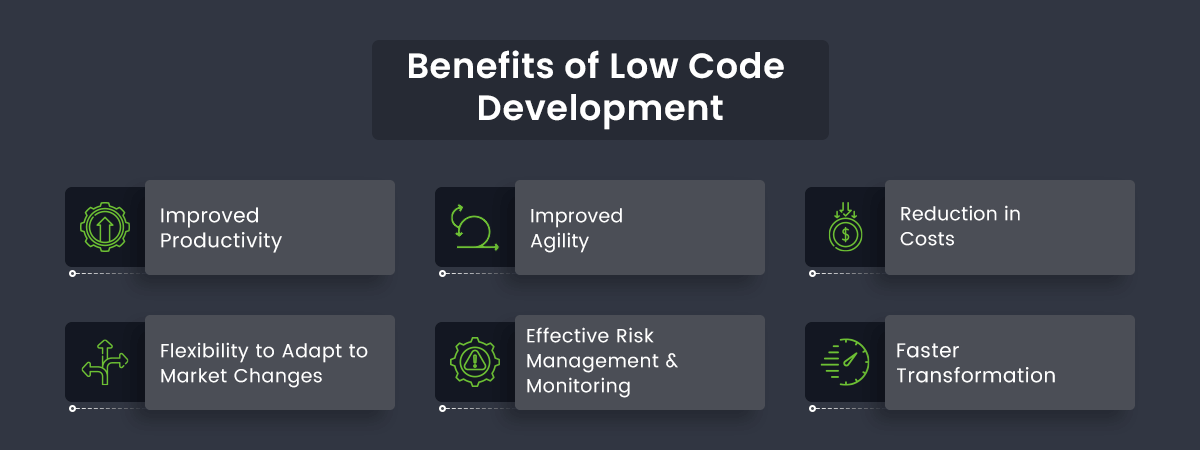
- Improved Productivity
- Improved Agility
- Reduction in Costs
- Flexibility to Adapt to Market Changes
- Effective Risk Management and Monitoring
- Faster Transformation
What are the challenges of low-code development?
- Debugging Challenges
- Learning Curve and Time Investment
- Visual Development can’t handle Complex Use Cases
- Integration can be challenging
1. Debugging Challenges
Problem – It is challenging to debug apps built on low code app development platforms.
It can be difficult to debug the frontend and backend code of a low code app. In traditional apps, developers can easily access all the data structures and algorithmic states to identify the issue or cause of the issue at hand. Low-code apps hide all this information from the developer.
2. Learning Curve and Time Investment
Problem – Low code is not taught in academic institutes. Hence you will need to invest time in learning how to use low code app development tools.
Though low-code app development isn’t that difficult to learn, it is still a new environment that most developers have never interacted with before. It is mainly based on JavaScript, but you won’t fully utilize its potential without spending considerable time understanding the platform and development approach.
3. Visual Development can’t handle Complex Use Cases
Problem – Solving complex business logic requirements is easier with a line of code than relying on visual languages.
When you build a complex business logic using visual languages like Business Processing Modeling Notation (BPMN), it becomes more complicated and chaotic than writing a simple line of code to solve the problem. In such situations, the low code app development approach becomes more of a hurdle than help.
4. Integration can be challenging
Problem – Integrating with some popular services can be simply impossible with the limitations of your low-code app platforms.
The comfort of calling an API for basic tasks like authentication is so common that we don’t realize its value when working with traditional app development. Even if a traditional app platform doesn’t provide it out-of-the-box, developers know they can integrate it themselves by adding the necessary code. This, however, is not possible with low-code app development.
Low Code App Development Products
Low code app development can be used for various purposes like building a mobile app, website, advanced spreadsheets, and more. There are many sub-categories under the broad umbrella of low-code development. You should know about the various services and functions you can carry out by adopting low code development best practices –
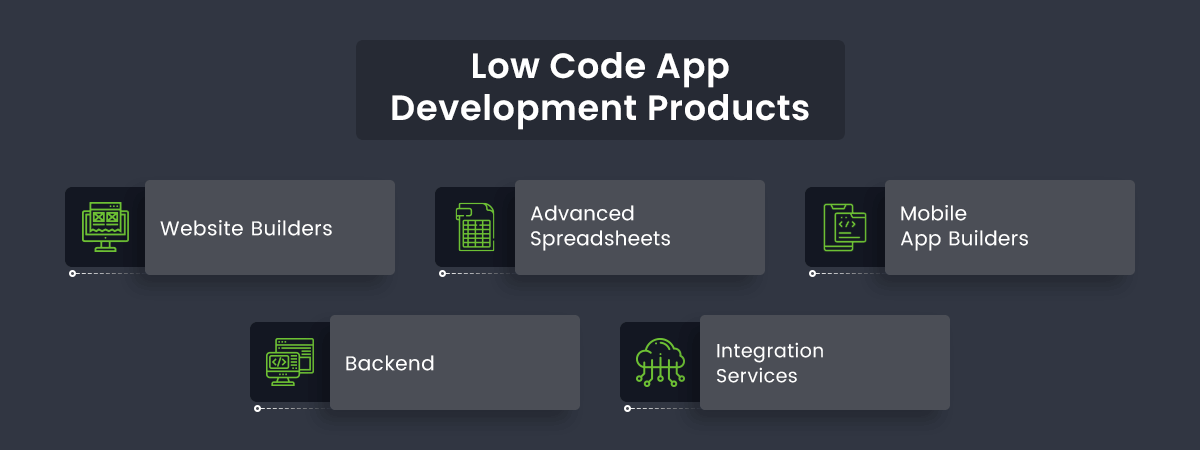
| Low Code Development Products | Description | Popular Examples |
|---|---|---|
| Low Code Web App Builders |
|
Wix, Webflow |
| Advanced Spreadsheets |
|
Airtable, Coda |
| Low Code Mobile App Builders |
|
AppSheet, Glide, Draftbit |
| Backend |
|
Xeno, Backendless |
| Integration Services |
|
Integromat, Zapier |
What apps can you build with low code?
So far, we have caught the gist of the capabilities and certain limitations of low code app development. However, how would you know for sure if low-code app development is for you? Understanding the various types of apps can be built using low code app development, of course! Let’s get right into it –
- Enterprise Resource Planning
- Healthcare Management
- Employee Onboarding
- Case Management
- Logistics
1. Enterprise Resource Planning
Enterprise Resource Planning (ERP) is the integration of all management functions of any organization. It provides you with in-built customizable logic. You can use low code development with ERP for creating a remote workforce that can perform tasks within a short period. Moreover, you don’t need any extra coding as the cloud platform covers the security aspect.
2. Healthcare Management
Low-code app development is often popularly used for being quick and flexible. Hence it can be used for the healthcare requirements of any patient. It can be integrated into the existing IT infrastructure and procedures without having to disturb the ongoing processes.
3. Employee Onboarding
One of the most significant cost considerations for any business is the employee onboarding expenses. Setting up a proper software for employee onboarding can be a complicated, tiring, lengthy and expensive affair. However, if you use low-code software, you can quickly create an effective custom system with employee details at a fraction of the cost. This will make the entire onboarding process easier and economical to manage.
4. Case Management
You can use low code development for developing case management software. Case management platforms include provisions for fraud investigation, claims, client onboarding, and IT service requests. This platform helps streamline all such services by improvising coordination, productivity, and automation. Using a low-code app development platform for case management can help provide more time for improvisation while committing fewer errors.
5. Logistics
You can build an automated operational software by digitalizing man-made processes, analyzing the data for efficient inventory control, and tracking on-time deliveries using a low-code app platform. You can also create quick app solutions for the franchise, donor, and other related services.
Selection Criteria for Choosing the Best Low Code App Development Platform
Now that we know the importance, relevance, and potential of low code app development platforms, we should focus on selecting the best low code application platform for your project. How to set your selection criteria for selecting the best low code software is crucial – as it can either make or break your organization.
The final selection of the ideal low-code app development platform depends on fundamental questions like –
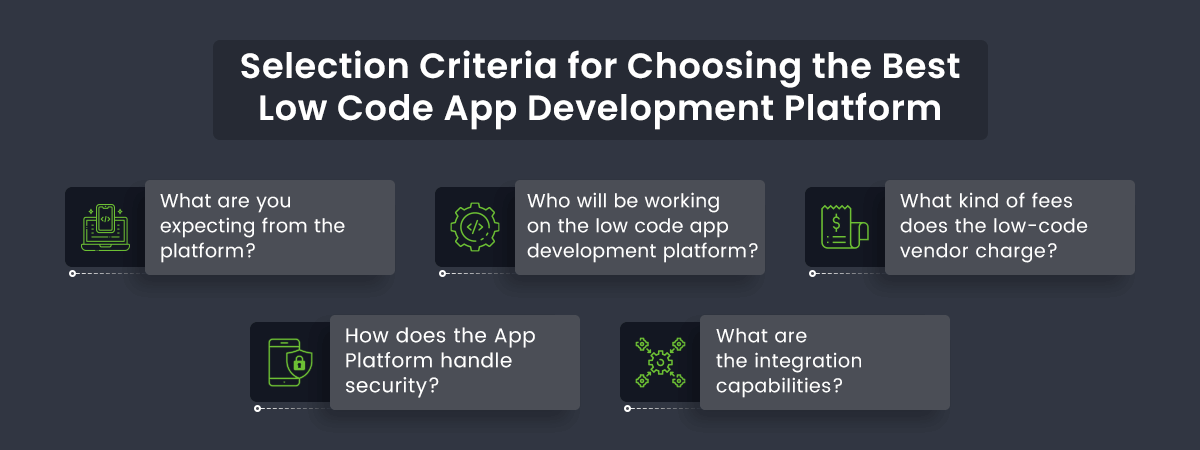
1. What are you expecting from the platform?
As we already discussed, there are many kinds of low-code development tools. Some help you build mobile apps, whereas others are used for websites or web apps. Other specialized solutions cater to specific industries. Hence, you can quickly eliminate or shortlist the available platforms for your requirements by shortlist what kind of app you want to make.
You can invest in either an industry-specific low-code management tool with deep capabilities or an all-purpose general low-code app development tool that is more cost-efficient. It all depends on your budget and requirements.
2. Who will be working on the low code app development platform?
Another important consideration naturally is who will be using the low code app development platform. Are you an individual or a non-technical person trying to build an app using the perks of the low-coding app development approach? Or are you a professional developer who has prior coding knowledge who wants to use low code app development tools with a higher level of customization options? Your knowledge of coding can again help shortlist the possible tools you can use for low-code app development.
If you are a technically skilled developer, you can opt for low-code app development tools that require a certain degree of coding knowledge and provide more customization options. If you are a non-technical or ‘citizen developer,’ you might have to rely on low-coding platforms that do not need prior coding skills.
3. What kind of fees does the low-code vendor charge?
Not all licensing structures are created in the same manner. Some low-code development tools appear to be inexpensive at first but surprise you with several hidden fees as you start using them. Here are some of the standard fees you should know about –
| Additional Low-Cost App Cost | Description |
|---|---|
| Developer Seat Fees | Fees are charged based on the number of people who will be building apps with the platform. |
| Run-time Fees | Not that common, but you should look out for them. This fee is charged every time your generated app runs on any device. |
| End-user Seats | Fee charged based on the number of people using the application built by the developers. |
| Distribution Fees | Some low-code app development platforms charge a distribution fee per application, which can get expensive. |
4. How does the App Platform handle security?
For any kind of app development, security plays the most crucial role in gaining customer trust and safeguarding the company against legal lawsuits. When assessing the security aspects of a low-code app, you should assess it on two fronts –
Internal Security
You cannot give your users unlimited access to your data. When assessing the internal security practices of your preferred low code platform, ask these questions –
- Does the platform let your IT department control data and user access?
- Can you secure your data by assigning user roles?
External Security
What are the provisions for safeguarding your low-code app from external threats? Ask questions like –
- How does the low-code development platform store passwords?
- What encryption algorithms and implementations get used?
5. What are the integration capabilities?
There are good enough chances that you’re not looking to create stand-alone low code apps that work independently of your pre-established systems. Hence, integration is an essential aspect for selecting the right low-code tool. Consider these questions when selecting the best low code tool for your project –
- What type of data sources does it connect with?
- Does it offer read/write services, or is it read-only?
- How will it integrate with your existing software?
Popular Low-Code App Development Platforms in 2024
Now let us discuss the top low-code app development platforms that you can use for your app development projects. Each of these top low code platforms has its unique selling points and features.
Have your app requirement plan ready, and then asses these platforms for their merits to see which one suits your needs the best.

- Appian
- Outsystems
- Zoho Creator
- Kissflow
1. Appian
Appian comes with a free trial period. It is considered one of the top low-code app development platforms amongst developers due to the variety of features. It provides 100 percent automation of your app development process.
Appian is an app builder that claims to make the app development process 20 times faster. Many organizations use it for improving their customer experience, handle risk management and achieve an excellent low-code app solution.
Key Features of Appian
- No technical knowledge is needed for using Appian
- Allows you to develop and deploy apps instantly
- API integration and configuration is seamless
- Apps made on Appian work smoother on your preferred devices
- Offers enhanced security certifications
What can you create with Appian?
- Responsive web apps
- Hybrid apps
- Workflows
2. Outsystems
Outsystems is one of the best low code app development platforms that allow you to develop apps and upgrade them as per your business and technical needs. With Outsystems, you can create full-stack app solutions without prior technical skills and deploy the app with a single click. Additionally, if you are an experienced developer, Outsystem has more to offer. It allows you to use your custom codes in-app scripts for adding some additional features. It has specific security protocols in place as well.
Key Features of OutSystems
- 24×7 customer support through e-mail, chats, phone
- Provides learning courses
- Has a collaborative environment for including your team
- Real-Time performance dashboard to monitor the health of your app
- Easy integration capabilities
What can you create with OutSystems?
- Omnichannel Digital Customer Experiences
- Morden applications
- Case Management Solutions
3. Zoho Creator
Zoho Creator is one of the most promising low code app development tools for business transformation and analytics. It offers cross-platform app development capabilities and can be used by businesses of all sizes to create mobile applications from scratch. You can build and publish apps immediately on iOS and Android platforms.
Key Features of Zoho Creator
- Graphical Interface Layer
- Custom Workflow and Business Automation
- Pre-Built Application Templates
- Set Role-Based Permissions
- Update Changes Instantly
- Zoho Creator Marketplace
What can you create with Zoho Creator?
- Cross-Platform Mobile Apps – iOS and Android
4. Kissflow
Kissflow is a workflow as a service platform that is used for automating business process workflows. It helps you create an unlimited number of automated business applications. It can also be used for tracking performance and is suitable for businesses of all sizes and industries.
Key Features of Kissflow
- Visual Workflow Tool
- Administrative Features
- Single sign-on
- Drag and drop WYSIWYG form designer
- Predefined app templates
What can you create with Kissflow?
- Process Management
- Custom Workflow Process
- BPM Platform
have a unique app Idea?
Hire Certified Developers To Build Robust Feature, Rich App And Websites.
Wrapping it up!
This is your go-to guide for low code app development. As you can see, low code application development has influenced all types of industries. It is not only limited to be used by startups. Keep these low-code app considerations in mind before starting your next low-code project.
Also Check:
